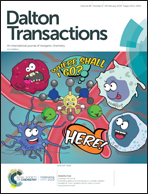Three polyoxometalates-based organic–inorganic hybrids decorated with Cu–terpyridine complexes exhibiting dual functional electro-catalytic behaviors†
Abstract
By adjusting polyoxometalates in the same POM/Cu/terpyridine reaction systems, three new organic–inorganic hybrid solid materials based on Cu–terpyridine complexes, [Cu3(tpy)3(H2O)2(HPMoVI8VIV4O40(VIVO)2)]·2H2O (1), Cu5(tpy)5(H2O)2(α-PW12O40)2 (2), and [Cu3(tpy)3(H2O)4(α-P2W18O62)]·4H2O (3) (tpy = 2,2′:6′,2′′-terpyridine), were prepared by using one-pot methods. X-ray structural analyses show that compounds 1–3 with a 1D chain structure constructed from Cu/tpy complexes were modified using bi-capped Keggin, Keggin and Wells–Dawson POMs. Compounds 1–3 have been fabricated to a bulk-modified carbon paste electrode to explore the electrochemical properties. Cyclic voltammetry demonstrates discrepant dual functional electro-catalytic activities toward the reduction of nitrite and the oxidation of ascorbic acid because of variant POMs. The results show that the PW12-Keggin-type hybrid exhibits a better dual functional electro-catalytic performance than bi-capped Keggin and Wells–Dawson hybrids for the reduction of nitrite and the oxidation of ascorbic acid.



 Please wait while we load your content...
Please wait while we load your content...